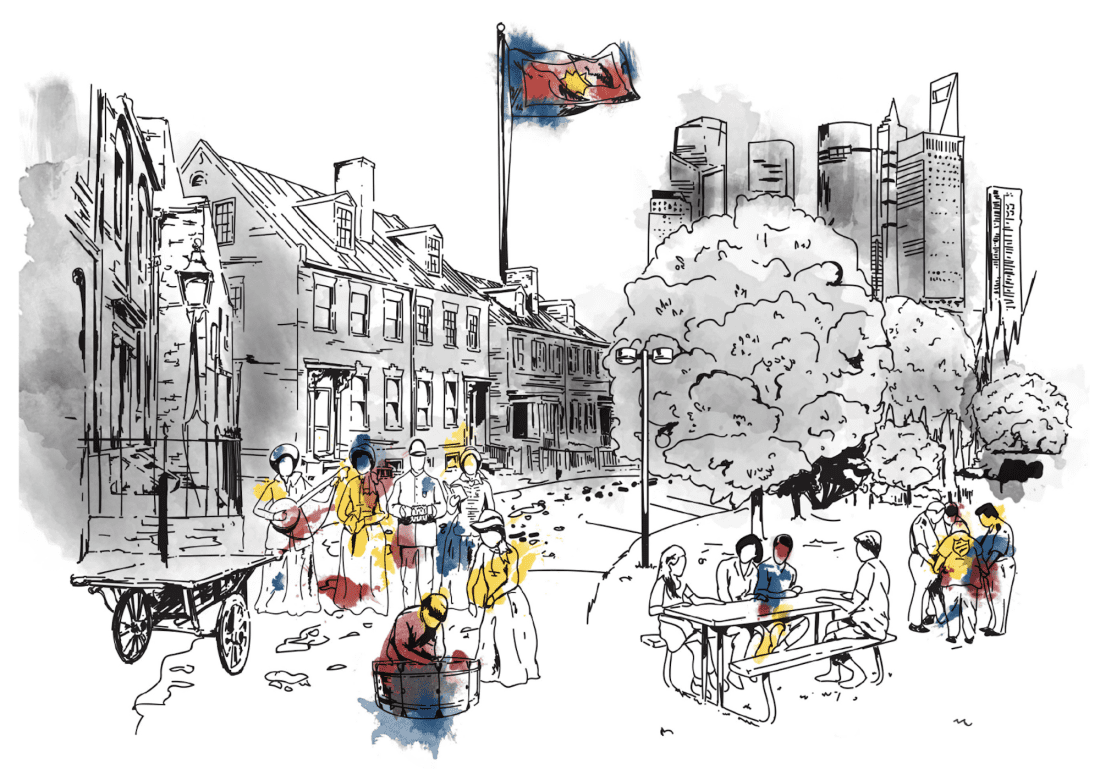The Church is a community which comes into being in response to the Kingdom of God through faith in Jesus the Christ as the one in whom the Kingdom is realized.
Jesus came preaching the Kingdom of God. By this term he meant both the establishment of God’s rule in human life—individual and corporate—and the amazing consequences of accepting this rule. The consequences were a reversal of the relationships characteristic of a fallen world order—for example, love not only of friends but also of enemies (Matthew 5:43-47), unlimited forgiveness of others (Luke 17:3, 4), service over status (Mark 10:42-45).
The gospel is the good news that in Jesus this Kingdom is now present and accessible (Luke 7:22; 17:21), that all of history is moving toward the Kingdom’s full realization in a transcendent order (Revelation 21:1-4), and that through faith in Jesus as the Christ (the Messiah of God) the Kingdom may be entered (i.e., salvation received) and a new life begun (Galatians 3:26; Ephesians 2:8). Through his voluntary death on the cross (John 10:18), the incomparable act of self-giving love, Jesus released power enough to bring this salvation into the world (1 Corinthians 1:17, 18) and to reconcile fallen humanity to himself (Colossians 1:20)—i.e., power enough to establish the Kingdom as a reality in human life. Through his resurrection from the dead, he demonstrated the Kingdom’s triumph in the cross and gave the promise of its completion in human life and history (1 Peter 1:3-9).
How the new humanity in Christ begins
This gospel is the starting point for the Church. The Church comes into being when the gospel is received—that is, when persons accept and enter the Kingdom through faith in Jesus. It is the fellowship of those who believe in Jesus as the Christ sent from God to heal the brokenness of human life and restore lost fellowship with God and man. It is the community of those who are bound together by a common faith in Jesus. We call this community “the new humanity” because it is based upon that which contradicts and supersedes the old, fallen humanity; it is, in fact, a new order of life based upon the gospel.
Because Jesus as the Christ is the one through whom the Kingdom is entered and realized, we speak of the Church as the community which is “chartered by Christ.” He is the one who delivers the Kingdom to the faithful and grants all the privileges, rights, protections and powers which life in the Kingdom entails. He is the Lord of the Church, and the Church therefore lives in obedience to him. This obedience defines the Church’s life and action under Jesus’ lordship. The Church has a bias toward obedience rather than observance because of this called lordship. It is called not to perpetuate ritual but to step out in trusting obedience to its Lord’s commands. Discipleship is the Church’s way of life. The Church looks to its Lord not only as its Savior from the Kingdom of sin and death, but also as the source of authority and the norm of conduct in the new Kingdom. As the reliable, Spirit-inspired witness to Christ as the Word of God, the initiator of this new Kingdom and the Lord of life, the Scriptures are the written authority and norm for Christian faith and practice, and therefore for all ecclesiology.
In obedience to its Lord, the Church goes into all the world preaching the gospel (Mark 16:15, alternate ending) and attempting to make disciples of all nations (Matthew 28:19): its starting point is a universal gospel. The privilege of the Kingdom is for the whosoever (John 3:16). This means, of course, that citizenship in the Kingdom is freely chosen. The Kingdom is entered by faith, and since faith is the only act without merit, it is possible for any true seeker after God. The universal gospel implies entrance into the Kingdom as a free choice.
How the new humanity in Christ is celebrated and nurtured
In order for there to be true unity in the (universal) gospel, there must be freedom in the diversity of culturally conditioned forms, rituals, ceremonies and governments in the Church as a whole. The strength of the universal gospel is that it is the power of God for salvation to everyone who has faith, to the Jew first and also to the Greek (Romans 1:16). In order to protect this universality, the Church must allow for considerable diversity in the expression and nurture of faith, so that acceptance of the gospel does not depend upon simultaneous acceptance of a particular culture or ecclesiastical tradition and thereby nullify the universality. It is a disservice to the gospel to insist that grace must be received through the mediation of a particular ritual or procedure, and there is no evidence in the New Testament from which a case can be argued for such a view. Grace is immediate and accessible.
When the Word became flesh, God’s grace appeared for the salvation of all men (Titus 2:11), and from his fullness have we all received, grace upon grace (John 1:16). Each one of us… has been given his own share of grace, given as Christ allotted (Ephesians 4:7, JB).
The immediacy of grace, however, does not require the elimination of sacred rites. Man has a need to nurture and celebrate profound spiritual realities through symbolic acts. A Gnostic disparagement of palpable symbols and rituals which communicate through the senses is, or borders on, Christian heresy. What the immediacy of grace does imply is that no ritual can be seen as somehow necessary in order for someone to receive grace and that any ritual which faithfully conveys the gospel and adequately allows for response is appropriate. Each Chris-tian fellowship is therefore free to develop those symbolic acts which best nurture and celebrate a response to the gospel which is attentive to the social, cultural and historical context of its life and mission. Such freedom is necessary if the free grace of God is to be accepted by the Church and prescribed rituals in particular traditions not understood as the requisite means of experiencing that grace.
What, then, are the criteria for those rites which evoke and reinforce the reality of the Church as the new humanity chartered by Christ? The criteria are in fact those significant aspects of this reality which ought to be communicated in the rite. We list them as follows:
- The new humanity in Christ comes about through entrance into a totally new reality, the Kingdom of God now present in human life.
- It involves a change in life patterns and goals.
- This change is made possible through personal repentance and divine forgiveness.
- Jesus the Christ is the one through whom this forgiveness is offered and effected.
- Since he is also the one who is Lord in the new Kingdom, citizenship (discipleship) requires obedience to him and emulation of him.
- Personal response to Jesus as Savior, Lord and pattern is made in freedom.
Becoming a part of the new humanity in Christ is a step which should be recognized and celebrated publicly as a witness (Matthew 10:32).
It has the character of enlisting in an army, the discipline of which is necessary in enduring the hardship of living in the new Kingdom in the midst of a fallen and opposing world order.
In addition to conveying these aspects of the new humanity in Christ, the rite ought also to celebrate the immediacy of grace. Nothing in it ought to imply that grace is automatically prescribed or purveyed through the performance of the rite itself. Rather, the rite must be a celebration of the immediacy of grace to those who are the active participants. When a rite loses this celebratory and spontaneous character, it is near to becoming a peremptory ritual which claims to control and channel grace. In no way can a rite effect salvation; in no way can saving grace be received representationally.
Most Christian fellowships celebrate entrance into the new Kingdom through Christ by means of the rite of water baptism. Baptism is seen by these fellowships as a “rite of passage” signifying entrance into new life through Jesus Christ and union of the one baptized with Christ and with his people. The significance of the rite is drawn from Scripture references which associate baptism with important dimensions of conversion to Christ: participation in Christ’s death and resurrection (Romans 6:3-5; Colossians 2:12); a washing away of sin (1 Corinthians 6:11); a new birth (John 3:5); an enlightenment by Christ (Ephesians 5:14); a clothing in Christ (Galatians 3:27); a renewal by the Spirit (Titus 3:5); the experience of salvation from the flood (1 Peter 3:20, 21); an exodus from bondage (1 Corinthians 10:1, 2); and a liberation into a new humanity in which barriers of division whether of sex or race or social status are transcended (Galatians 3:27, 28; 1 Corinthians 12:13).
A Salvationist ecclesiology affirms these dimensions of conversion. It also acknowledges that water baptism was adopted by a major part of the New Testament Church as a rite which had both the potential to evoke suggestions of these spiritual dimensions and precedent in both Jewish and pagan cultural practice. But it also avers that neither Jesus nor the apostles intended to establish that particular rite as an indispensable part of true Spirit baptism,6 and that readings of scriptural references to “baptism” as a spiritual experience, that see water baptism as a necessary component of the event, are theologically unjustifiable.
Water baptism, then, cannot stand on its own—no more than can any other religious rite. It is no more than a sign of an inner experience, and without the independent reality of the inner event, the rite is a mere form. The sign of baptism can be a very effective witness to the world of the transformation wrought by faith if, in fact, the evidence supports the claim. It reinforces the convert in his new commitment, and it reminds the gathered fellowship of the commitments they have made. Rich in the symbolism of death and resurrection, a washing away, cleansing, rebirth and renewal, it is a fitting representation and confirmation of the conversion that has taken place.
But it is not the only public witness to this spiritual reality. The Salvationist fellowship has its own rites of public witness to conversion. When the gospel is preached in Salvation Army meetings (services of worship), persons are invited to respond by coming forward and kneeling at a mercy seat (a place of prayer), thereby signifying their penitence, desire for conversion, and personal resolve. The symbolism of this action is reminiscent of Jesus’ frequent call for would-be disciples to step out, leave what they have and follow him (see Luke 9:57-62). The kneeling at the mercy seat points to the true humility of those who see the inadequacy and shame of their life outside discipleship, and the longing to be converted to true discipleship through spiritual death and resurrection. Through faith the seeker rises from the mercy seat a new person in Jesus Christ (2 Corinthians 5:17).
There is, of course, no guarantee of conversion by virtue of the act of coming to the mercy seat, nor is this regarded as an essential precondition of membership. The coming forward is only a sign that a search is in progress and conversion is contemplated. As such, it strengthens the seeker and elicits the support of the congregation in concerned prayer. In actuality, the mercy seat itself is symbolic of any place where a seeker after God comes in prayer. The true mercy seat is of the heart, and the outward act of kneeling at a prayer bench, or any other place, is nothing if not the outward sign of the kneeling soul.
The new convert is prepared for soldiership (membership) during a period of time as a recruit. Then he is enrolled as a soldier in a public ceremony. This enrollment or swearing-in signifies an important dimension of response to the new Kingdom through faith in Jesus: it stresses discipleship. Having entered the Kingdom, the convert becomes a disciple who follows Jesus as Lord and patterns his life accordingly. The soldier enrollment makes clear that discipleship is the purpose of conversion, and it celebrates the convert’s acceptance of this calling by utilizing the military metaphor of enlistment into a life of spiritual discipline and warfare (Ephesians 6:11-17; 1 Timothy 6:12; 2 Timothy 2:3, 4). The convert is enrolled as a soldier under the flag of The Salvation Army whose pattern and colors are symbolic of the redeeming blood of Christ, the refining and empowering fire of the Holy Spirit, and the purity of God and of those who single-mindedly serve him. Again, the ceremony of itself has no efficaciousness apart from the integrity and seriousness of the convert who is taking the step.
It should be noted that in The Salvation Army young persons can be enrolled as junior soldiers. There is no requirement that a person must reach young adulthood before he is capable of discipleship. Rather, since Jesus used the trusting attitude of little children as analogous to religious faith (Mark 10:14, 15), the Army allows children to make a faith response and to be enrolled as soldiers. As such they are nurtured in the faith, and they serve according to their abilities and maturity.
Summary
Let us now summarize the contributions of Salvationist ecclesiology to an understanding of the Church as the new humanity chartered by Christ. Here are the doctrines emphasized by the Salvationist movement.
First, the Church is comprised of those who have received and give witness to the immediacy of God’s grace in Jesus Christ. The Kingdom is received through faith, and this faith saves quite apart from rituals and ecclesiastical prescriptions. The new humanity takes its stand in the accessibility of saving grace over against all attempts to mediate grace through office or ritual. Along with the Society of Friends (Quakers), The Salvation Army witnesses to the whole Church that in Christ the saving grace of God is accessible to the whosoever and efficacious for all who have faith in Christ irrespective of office or ritual.
Second, all who have entered God’s Kingdom of grace share one baptism of the Holy Spirit and one obedience to Jesus Christ. The new humanity in Christ is a unified body, and this corporate unity consists of a shared status through spiritual baptism and a shared mission under the command of Jesus Christ. Hence, the basis for Christian unity can never be uniformity or even similarity of government, ritual, or claims to historic apostolic succession. Christians are truly united in their spiritual baptism, quite apart from the specific ritual that is followed in order to express and celebrate this conversion; and in their commitment to obey the missional Christ while affirming the unique mission-al strengths of different Christian fellowships. There is no other basis for Christian unity. This is clear when we view the varieties of ritual practice among those who accept Jesus as Lord.
Third, entrance into the Kingdom and participation in the new humanity in Christ are synonymous with accepting the challenge of discipleship. Conversion in the initial sense is not an end in itself. It is that beginning experience of divine love, acceptance and forgiveness which frees the convert to realize his potential in Christ by becoming a disciple. Discipleship is the corollary of confessing Jesus as Lord. It is the means by which the Church pursues its calling and carries out its mission in the world. It is obedience to Jesus Christ, and, as such, the way of life of the new humanity. There is no other way to participate in the Kingdom.
Fourth, the rituals of the Church—whether spontaneous or institutionalized—are signs of spiritual events, celebrations of God’s grace in human life, and witnesses to God’s transforming presence. They point to divine reality. They are not themselves that reality, nor do they somehow affect the work of grace. They can be spiritually illuminating and often elicit an overwhelming sense of God’s presence, but that is the case only when they are performed in response to the gracious work of God in human life, and as a symbolic witness to what God has in fact wrought. Rituals such as water baptism or soldier enrollment affect nothing. They are outward, symbolic expressions of spiritual transformation. They are the witness of a community which has come into being in response to the Kingdom of God through faith in Jesus the Christ as the one in whom the Kingdom is realized.
Author Q&A: Missional moment in conversation
On the question of baptism you state: “A Salvationist ecclesiology affirms…that neither Jesus nor the apostles intended to establish [water baptism] as an indispensable part of true Spirit baptism, and that readings of scriptural references to ‘baptism’ as spiritual experience, that see water baptism as a necessary component of the event, are theologically unjustifiable.” Can you clarify the point further?
Salvationists today do not need to expend energy in defending The Salvation Army’s position on non-practice of water baptism. As the chapter explains, there was necessity and good reason for discontinuing the practice. Nor is there need completely to close the door—as William Booth refused to do—to
the possibility of allowing the voluntary practice of water baptism consistent with Salvationist theology and missional priority.
How do you personally respond to those who say that although baptism may not be necessary to salvation nor to the infilling of the Holy Spirit, it is
commanded as an act of obedience? They say this implies that those who do not practice water baptism are being intentionally disobedient.
Why would Jesus command his followers to do some specific thing—like baptize with water—just to demonstrate a meaningless obedience to him? Does Jesus’ ego need that? The obedience Jesus asks of us is the obedience of disciples, the obedience that is aimed at forming us in his image. Water baptism is
either commanded of Jesus’ disciples, or it is not. If not, how we mark, affirm, and celebrate conversion in helpful ways is left up to the spiritual wisdom and discernment of his disciples in their particular missional context.
You state: “The immediacy of grace… does not require the elimination of sacred rites. Man has a need to nurture and celebrate profound spiritual realities through symbolic acts.” With many wanting to be more closely aligned in practice with the universal Christian church, what would you see as the advantages and disadvantages of The Salvation Army incorporating water baptism as a symbolic ritual?
Assuming that we defined and practiced water baptism consistent with Salvationist theology and missional priorities, the advantages would be: a) a clear and practical identification with Christ’s church, which (with the exception of the Society of Friends) universally practices water baptism in one form or another; b) a strong statement distancing ourselves from a gnostic understanding of salvation; and c) facilitation of our legal recognition and status as a church in countries which deny it because of the influence or history of a state church. The disadvantage would be that non-practice has been our tradition for so long, re-institution would be complicated and potentially divisive. It would have to be handled with considerable wisdom.
What are the ritualistic dangers we The Salvation Army can fall into, or have already fallen into? How can we avoid them?
Our claim not to be dependent on “rituals” has two problems. First, the claim is false. We do have our rituals, and they are sometimes as sacralized as we accuse the practice of water baptism by other Christians to be. Second, we are often unaware of (or too willing not to admit) the possible pitfalls of our replacements of historical Christian practices. We have replaced these rituals with our own inventions, which may more easily lack the proven value, focus, and doctrinal foundations of almost twenty centuries of Christian discovery, experience, and theological reflection. The only way to avoid the dangers is ongoing objective reflection on our practices, combined with honest insight into the specific ways the rituals are, or are not, helping Salvationists on their journey as disciples of Jesus.
Reflection Questions: Missional movement
1. What are some specific steps your corps could take to cultivate a way of life within the corps fellowship that reflects the values of the Kingdom of God introduced by Jesus and made possible by his death and resurrection?
2. When we, as Salvationists, observe the symbolic Salvation Army rituals, what should the outcome be for the practical day to day mission of The Salvation Army? What are the ritualistic dangers we in The Salvation Army can fall into? How can a local corps avoid them?
3. What symbolic rituals in The Salvation Army are most often seen or more likely to be seen by people as a rite necessary to a higher relationship to God and
not just one of a number of possible helps to this end?
4. What are the symbolic rituals we should continue and why? Are there any rituals we should consider dropping? Explain why each of your choices (both to continue and to discontinue) is a good idea.
5. With our large social service programs, can The Salvation Army as a movement fall into the danger of being ritualistic—and therefore decreasingly responsive to real, current needs and open to better responses—in its service and outreach? How can we avoid this?
Taken from “Community in Mission” (Frontier Press, 2016) by Phil Needham. Receive the free digital version of the book by opting in below.
Do Good:
- Read “Community in Mission” (Frontier Press, 2016) by Phil Needham.
- Get inside the Caring Magazine Scripture Study Collection and find a suite of free, downloadable Bible studies to guide you through topics from New Beginnings Through Forgiveness, to Understanding our Imago Dei or Life Hacks From David.













